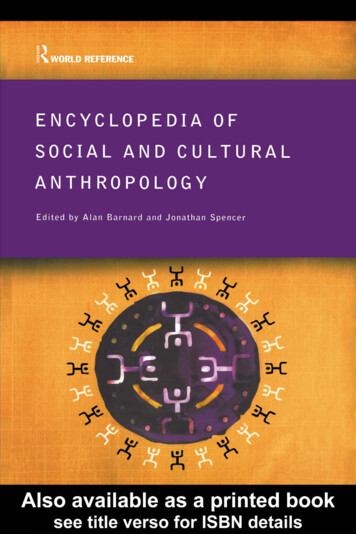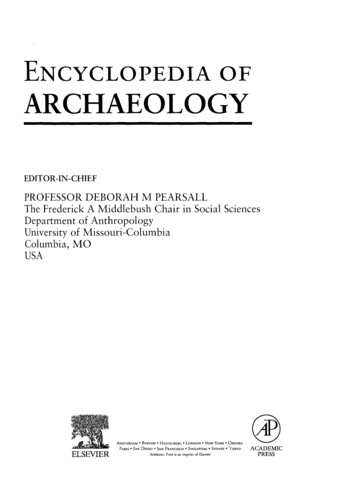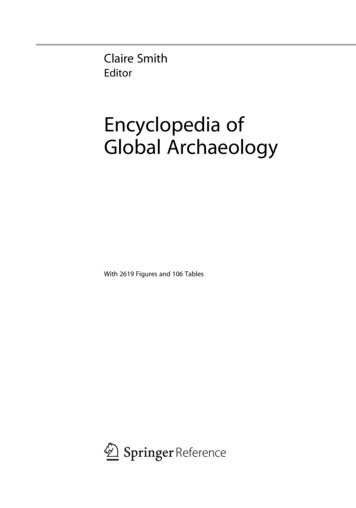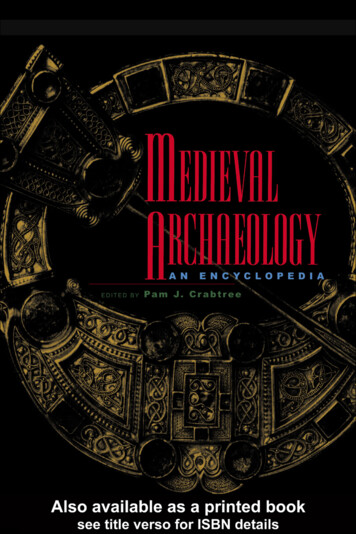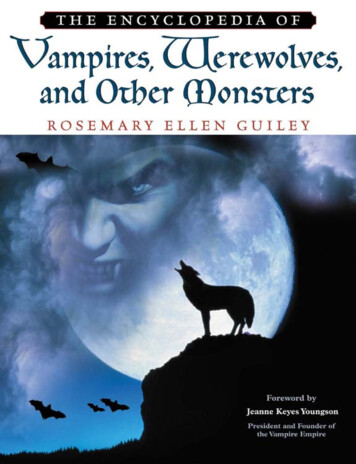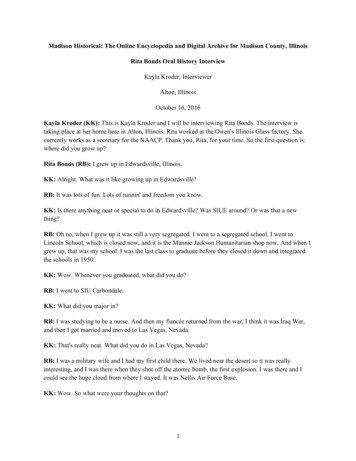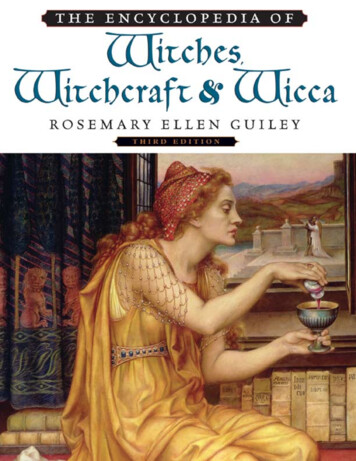
Transcription
Witches, Witchcraftand WiccaThird EditionSSTHE ENCYCLOPEDIA OF
Also by Rosemary Ellen GuileyThe Encyclopedia of Angels, Second EditionThe Encyclopedia of Ghosts and Spirits, Third EditionThe Encyclopedia of Magic and AlchemyThe Encyclopedia of SaintsThe Encyclopedia of Vampires, Werewolves,and Other Monsters
Witches, Witchcraftand WiccaThird EditionRosemary Ellen GuileySSThe Encyclopedia of
The Encyclopedia of Witches, Witchcraft and Wicca, Third EditionCopyright 1989, 1999, 2008 by Visionary Living, Inc.All rights reserved. No part of this book may be reproduced or utilized in any form or by any means,electronic or mechanical, including photocopying, recording, or by any information storage orretrieval systems, without permission in writing from the publisher. For information contact:Facts On File, Inc.An imprint of Infobase Publishing132 West 31st StreetNew York NY 10001Library of Congress Cataloging-in-Publication DataGuiley, Rosemary.The encyclopedia of witches, witchcraft and wicca / Rosemary Ellen Guiley. — 3rd ed.p. cm.Rev. ed. : The encyclopedia of witches and witchcraft . 1999.Includes bibliographical references and index.ISBN-13: 978-0-8160-7103-6 (hardcover : alk. paper)ISBN-10: 0-8160-7103-9 (hardcover : alk. paper)1. Witchcraft—Encyclopedias. 2. Witches—Encyclopedias. I. Guiley, Rosemary.Encyclopedia of witches and witchcraft. II. Title.BF1566.G85 2008133.4'303—dc222008008917Facts On File books are available at special discounts when purchased in bulk quantitiesfor businesses, associations, institutions, or sales promotions. Please call our Special SalesDepartment in New York at (212) 967-8800 or (800) 322-8755.You can find Facts On File on the World Wide Web at http://www.factsonfile.comText design by Cathy RinconCover design by Salvatore LuongoPrinted in the United States of AmericaVB Hermitage 10 9 8 7 6 5 4 3 2 1This book is printed on acid-free paper and contains30 percent postconsumer recycled content.
SFor Jo Clark
Acknowledgments ixIntroduction xiEntries A–Z 1Bibliography 407Index 415SSContents
SSAcknowledgmentsFoxwood, Christopher Penczak, Raven Digitalis, GavinBone, Janet Farrar, Gavin and Yvonne Frost, Isaac Bonewits, Deborah Lipp and Carl Weschke.For the third edition of this encyclopedia, I would like especially to thank the following individuals for their help:Laurie Cabot, Selena Fox, Raymond Buckland, Z Budapest, Marion Weinstein, Oberon Zell-Ravenheart, Orionix
SSIntroductiona way of eliminating rival religious sects, political enemies and social outcasts. From the 14th to 18th centuries,thousands of people—perhaps hundreds of thousands—were tortured, jailed, maimed and executed on charges ofwitchcraft. Many of them were innocent, framed by personal enemies or tortured into confessions.They told lurid stories of signing pacts with the Devilin blood, of being given demons in the form of animalfamiliars that would do their malevolent bidding and ofattending horrid feasts called sabbats, where they wouldkiss the anus of the Devil and roast babies for a meal.None of these tales was ever substantiated by fact, butthey served as sufficient evidence to condemn those whoconfessed to them.The accused also admitted to doing evil to their families, friends, neighbors, rivals and enemies. How muchof that was true is uncertain. Folk magic practices werepart of everyday life, and casting a spell against someone,especially to redress a wrong, was commonplace. Sincemost confessions were extracted under fear and torture,it is likely that a great deal of untruth and exaggerationspilled out.In the American colonies, the Puritans were obsessedwith evil and believed the Devil had followed them acrossthe ocean from England to destroy them. No wonder thisparanoia erupted into witch hunts, including those in Salem, Massachusetts, in 1692, when the tales of hystericalgirls were enough to send people to their deaths.The stigma upon witchcraft left by the Inquisition andwitch hunts lingers to this day, perpetuated by lurid filmsCenturies ago, the inquisitors and witch-hunters who executed witches as servants of the Devil believed they weredoing a service to God and humanity. They envisioned asociety free of witchcraft, which they viewed as heresy, ascourge, an evil and a blight. They would be astonished today to find that Witchcraft—with a capital W—has becomeone of the fastest-growing religions in Western culture.How did this 180-degree turn take place?The road from sorcery to spirituality is a colorful one,full of secrets, twists, rituals and compelling personalities. In its short half century as a religion, Witchcraft hasa history rivaling that of any of the world’s great faithsin drama, intrigue, pathos and triumph. Witchcraft hastaken its place in the ecumenical religious theater.Traditionally, witchcraft—with a small w—is a formof sorcery, concerned with spells and divination. Themagical witch, the sorcerer witch, was not practicing areligion of witchcraft, but was practicing a magical art,passed down through families or taught by adepts.Witches have never enjoyed a good reputation. Almostuniversally since ancient times, witchcraft has been associated with malevolence and evil. Witches are thoughtto be up to no good, interested in wreaking havoc andbringing misery to others. Individuals who used the magical arts to divine and to heal often took great pains to callthemselves something other than “witch.”In Christianity, witchcraft became interpreted as serving the Devil in his plan to subvert and destroy souls. Awitch hysteria mounted in Europe, Britain and even theAmerican colonies and was seized upon by the church asxi
xii The Encyclopedia of Witches, Witchcraft and Wiccaand novels of baby-eating hags and Satan worshipersgathered in candlelit circles intoning ominous chants.Witchcraft as a religion was born in Britain after WorldWar II and came out of the closet when the anti-witchcraftlaws there were repealed in 1953. It is argued that GeraldB. Gardner, the man who more or less invented the religion, should have chosen another term besides witchcraftfor the mix of pagan, ceremonial magic and occult material he assembled. Perhaps witchcraft sounded secretive,exotic and forbidden. It certainly struck the right chordwith the public, who suddenly could not get enough ofwitches.Gardner may not have envisioned a worldwide religious movement, but that is what unfolded, first with theexport of Witchcraft to the United States, Canada and Europe, and then around the world. The “Gardner tradition,”as it became known, quickly mutated into offshoots.A spiritual tradition that reinvented pagan deities andrituals, combined with folk magic and ceremonial magic, proved to be what many people wanted. Alienated bythe dry, crusty rituals and somber dogma of patriarchalmainstream Christianity and Judaism, people were hungry for a spirituality that was fresh and creative. Witchcraft—as well as reborn Paganism, reconstructions ofpre-Christian and non-Christian traditions—offered justthat, along with independence, autonomy, a connectionto Nature and direct contact with the Divine. No need formeddling priests, ministers and clergy to guard the gatesto the Godhead—or the afterlife. Another appeal wasthe top billing given to the feminine aspect of deity—theGoddess. And, sensuality was honored and celebrated,not punished.Witchcraft the religion, along with its Pagan cousins,flourished in the blooming New Age counterculture ofthe 1960s and 1970s and then took hold on the edges ofmainstream society. In the years since its birth, Witchcrafthas solidified some in uniform codes, values and core beliefs. But at heart it remains fluid, constantly evolving inpractice and interpretation. Practitioners find Witchcraftempowering and believe it provides a powerful spiritualpath on a par with all other mystical, spiritual and religious paths. Dozens and dozens of Witchcraft and Pagantraditions exist, and new ones are born all the time.Witchcraft and Paganism have survived the first testsof time. The movements took hold in the baby boom generation. Now, the children and grandchildren of thosepeople are growing up Wiccan and Pagan, and new youngpeople are attracted to the fold in increasing numbers.But there remains that pesky word witchcraft,which still evokes Satan, evil and black magic to manyoutsiders.For decades now, Witches have argued about whetheror not Witch ought to be replaced with a term that doesn’tcome with so much negative baggage. Some have adoptedthe terms Wicca and Wiccan to describe themselves andtheir religion and also to distinguish who they are andwhat they do from folk magic.Today, most Witches stand firm by the terms Witchand Witchcraft, believing that the public can and shouldbe reeducated about both. They have made headway,for Witchcraft/Wiccan churches are recognized legally,Witch holidays have gained some official recognition,and, in the United States, Wiccan military veterans havewon the right to have the pentacle, their religious symbol,placed on their tombstones.The different kinds and definitions of witchcraft pre sent a challenge in putting together an encyclopedia.First, there is witchcraft the magical art, which deals withsorcery, spell-casting for good or ill, healing and divination. Then there is the Inquisition witchcraft, the allegedDevil worship. And then there is Witchcraft the religion.All three overlap, and all three are covered in this volume.Most of the topics deal with the history and evolution ofwitchcraft in the West, though there are entries of crosscultural interest.I have used a lower-case w to describe folk and Inquisition witches and witchcraft, and a capital W to refer tothe modern religion. I have also used the terms Wicca andWiccan for the modern religion. Likewise, a lowercase p inpagan and paganism are used for pre- and non-Christianreferences, while a capital P refers to modern religioustraditions. Witchcraft the modern religion is considered aform of Paganism, but there are many forms of Paganismthat are not Witchcraft.Topics include folklore, historical cases and events,biographies, descriptions of beliefs, rites and practicesand related topics. For the third edition, I have addedentries in all categories and have updated entries to reflect changes and developments. Students of the Salemwitch hysteria will find individual biographies on the keyvictims.Witchcraft is a topic of enduring interest and study. Inone respect, it peeks into a shadow side of the occult andthe dark underbelly of human nature. In another respect,it opens into a realm of spiritual light.The church may never officially apologize for the Inquisition, which destroyed many people other than accused witches. Perhaps the success of Witchcraft the religion is karmic payback for a campaign of terror in thename of religion.— Rosemary Ellen Guiley
Aabracadabra A magical spell consisting of a singleword, which was popular in medieval times to get rid ofillness, misfortune or demons. The word is inscribed onan amulet (see amulets) or written out on paper in amagical inverted triangle, in which one letter of the wordis dropped in each succeeding line, until nothing is left.The evil is supposed to fade away just as the word does.The diminishing word technique is used in many otherspells for the same purposes.In medieval times, abracadabra was believed to wardoff the plague. The triangle was written on a piece of paper, which was tied around the neck with flax and wornfor nine days, then tossed backwards over the shoulderinto a stream of water running toward the east.The word’s origin is unknown. It is said by some tohave been invented around 208 by Quintus Serenus Sammonicus, physician to the Roman emperor Severus, as acure for fever. Some hold that Sammonicus merely borrowed a formula that was much older.According to others, the word comes from the oldAramaic phrase, abhadda kedhabhra, “disappear likethis word,” or the Hebrew phrase abreq ad habra, “hurlyour thunderbolt even unto death.” It is also said to bederived from the name Abraxas, the Gnostic god whoappears on charms against the evil eye dating from thesecond century. Another possibility is that it is the nameof some long-forgotten demon. Increase M ather dismissed it as a “hobgoblin word” that had no power atall. Aleister Crowley, on the other hand, said it is amagical word of great power and that its true form isabrahadabra.See charms.Further reading:Farrar, Janet, and Stewart Farrar. A Witches Bible Compleat.New York: Magickal Childe, 1984.Abramelin the Mage (1362–1460) A Jew from Würzburg, Germany, Abraham, or Abramelin (also spelledAbra-Melin), created a body of magical works that forcenturies influenced magicians, including AleisterCrowley. An expert on the Kabbalah, Abramelin saidhe learned his magical knowledge from angels, who toldhim how to conjure and tame demons into personal servants and workers, and how to raise storms (see stormraising). He said that all things in the world were createdby demons, who worked under the direction of angels,and that each individual had an angel and a demon asfamiliars. The basis for his system of magic, he said,may be found in the Kabbalah.According to lore, Abramelin created 2,000 spirit cavalrymen for Frederick, elector of Saxony. He also is saidto have aided an earl of Warwick in his escape from jailand helped save the antipope John XXIII (1410–15) fromthe Council of Constance.The magic of Abramelin allegedly is contained in amanuscript, The Sacred Magic of Abramelin the Mage, actually a collection of three books. The manuscript waswritten in French in the 18th century but claims to be
Adler, Margota translation of Abramelin’s original manuscript in Hebrew, dated 1458. It was translated into English aroundthe turn of the 20th century by S. L. MacGregor Mathers,one of the early and most influential members of the Hermetic Order of the Golden Dawn. Crowley borrowedfrom the book for his own rituals to master demons, andGerald B. Gardner used it as a source for his book ofshadows.Abramelin magic is similar to that found in The Keyof Solomon, considered the leading magical grimoire (seegrimoires). It is based on the power of numbers and sacred names and involves the construction of numerousmagical squares for such purposes as invisibility, flying,commanding spirits, necromancy, shape shifting (seemetamorphosis) and scores of other feats. Rituals for conjuring spirits, creating magic squares and making sealsand sigils are elaborate and must be followed exactly inaccordance with astrological observances.Further reading:MacGregor-Mathers, S. L. The Book of the Sacred Magic ofAbra-Melin the Mage. Wellingborough, England: TheAquarian Press, 1976.Adler, Margot (1946– ) American Pagan, author andjournalist, Adler is the first writer to chronicle in detailthe emergence and evolution of Paganism in the UnitedStates. The results of her research, Drawing Down the Moon(1979; 1986; 1995), make up a meticulous landmark studyof a highly complex and diversified religious movement.Adler’s interest in Paganism began with an early fascination with ancient Greek deities. Born April 16, 1946,in Little Rock, Arkansas, she grew up in New York Cityas the only child in a nonreligious household: her fatherwas an atheist and her mother a Jewish agnostic. Psychiatry was a significant influence: her father and an aunt arepsychiatrists; her grandfather was renowned psychiatristAlfred Adler. Her mother was a radical educator.At age 12, Adler became acquainted at grammar schoolwith the pantheon of ancient Greek deities. She was particularly drawn to Artemis and Athena for their imagesof strength and power.While a student at the High School of Music and Art,Adler made a religious search, visiting different churches. She was attracted to the Quakers and their practice ofspeaking from the heart, and to the moving, ritual splendor of Catholic Mass in Latin.Religion then took a back seat to politics for a fewyears. From 1964 to 1968, Adler attended the Universityof California at Berkeley, where she earned a bachelor’sdegree in political science, and became increasingly involved in political activities. She participated in the FreeSpeech Movement and was jailed for demonstrating. Shehelped to register black voters in civil rights activities inMississippi in 1965. She was an activist against the Vietnam War, and demonstrated at the Democratic convention in Chicago in 1968.Margot Adler (Courtesy of Margot Adler)In 1968, she entered broadcast journalism, first asa volunteer for the radical/alternative radio stations inBerkeley and New York owned by the Pacifica Foundation. From 1969 to 1970, she earned a master’s degree injournalism from the Graduate School of Journalism atColumbia University in New York, and then went to workfor WBAI, Pacifica’s station in Manhattan. In 1971, WBAIsent Adler to Washington, D.C., to manage its news bureau operation there.In Washington, politics and religion came together forAdler. She devoted extensive coverage to environmentalissues, which stimulated her interest in nature writerssuch as Thoreau. She saw a connection between environmental issues and religion: the Judeo/Christian viewthat it is humans’ right to have dominion over the earthseemed flawed and had led to exploitation of nature andthe earth. In contrast, Paganism and animistic religionsviewed humankind as a part of nature equal with all other creatures and parts.On a trip to England, Adler investigated the historyof the Druids, and in the process discovered numerous Pagan organizations. She subscribed to The WaxingMoon, which led to her introduction to witchcraft andWicca.WBAI relocated Adler back to New York, where sheworked as a producer and then hosted her own live pro-
African witchcraft gram, Hour of the Wolf, which aired for two hours in theearly morning five days a week. Her show dealt with cutting edges in such topics as politics, women’s issues, thearts, ecology and religion. She hosted two other radioshows: Unstuck in Time and The Far Side of the Moon.She received a letter from two Witches in Essex, England, who were selling tapes of rituals to Waxing Moonsubscribers. At first, the idea of Witchcraft rituals on tapestruck Adler as a joke. She replied that she might air themon her radio program.The first tape she received was of the Drawing Downthe Moon ritual and the Charge of the Goddess. Itevoked childhood memories of beautiful Greek goddesses, and in a powerful moment, Adler realized that the ideaof becoming the Goddess as an empowering image wasnot only permissible but was being done by others. Shebegan to search for such people.In the early 1970s, contemporary Witchcraft was rapidly gaining adherents in the United States. Importedfrom England under the aegis of R aymond Buckland andRosemary Buckland, followers of Gerald B. Gardner,the Craft was modified by numerous American covens.Adler joined a study group in Brooklyn run by the NewYork Coven of Welsh Traditional Witches. Another grouphived off from that coven to observe the Gardnerian tradition, and Adler followed. She was initiated as a first degree Gardnerian priestess in 1973.Adler stayed in the coven about three years, then movedoff in new directions. She formed a Pagan Way grove inManhattan, which became an informal recruiting centerfor persons interested in Witchcraft and Paganism.A friend introduced Adler to New York literary agentJane Rotrosen, who suggested writing a book. Adler wasuncertain at first, then realized she was “on a nexuspoint . . . standing on a crack in the universe.” The timefor such a book was right. With Rotrosen’s help, Adlerdeveloped and sold a proposal.She spent three years researching and writing Drawing Down the Moon. She traveled around the country, interviewing about 100 persons and groups involved in thePagan/Wiccan communities. Originally, she intended toinclude Britain in her survey, but British groups and individuals proved reluctant to participate.To her surprise, Adler discovered that the Paganmovement is not what she had imagined: an integratedspiritual movement with environmental concerns. Somesegments did fit that image, while others were radicallydifferent. A decade later, the movement had become muchmore integrated and concerned with ecological issues, inpart, perhaps, due to the influence of books by Adler andStarhawk.Adler also was the first to note the connection between the revival of Wicca and the women’s spiritualitymovement. In later editions of Drawing Down the Moon,she chronicled the growing number of Pagans who entered the Unitarian Universalist churches. For some 10years, she was on the board of directors of CUUPS, theCovenant of Unitarian Universalist Pagans.Though she acknowledges that she is a Witch in theWiccan religion, Adler prefers to call herself a Pagan. Shefeels the term Witch has so many negative associationsthat it may never be reclaimed as a term of female powerand independence. Furthermore, what is now practiced as“Witchcraft” has nothing to do with the heretical “witchcraft” of the Inquisition.In 1977, two years into the book project, Adler leftWBAI. Upon completing Drawing Down the Moon, sheworked as a freelance reporter for National Public Radio(NPR) in Manhattan, then joined the NPR staff in 1979.She was priestess of a Gardnerian coven for five yearsuntil 1981, when she was awarded a prestigious one-yearNeiman fellowship to Harvard University. Following theNeiman, she returned to NPR in New York, but did notrejoin a coven or pagan group.On June 19, 1988, Adler married her longtime companion, Dr. John Gliedman, in a handfasting held outdoors on Martha’s Vineyard, Massachusetts. Selena Foxofficiated at the legal ceremony, conducted within a magiccircle made of flowers and greens. Adler and Gliedmanthen jumped the broom, according to tradition. A reception followed. The wedding was the first Wiccan handfasting to be written up in the society pages of the NewYork Times. A son, Alexander Gliedman-Adler, was bornin 1990.In 1997, her book Heretic’s Heart: A Journey ThroughSpirit & Revolution was published. It chronicles her upbringing as a “red diaper baby” and her involvement inthe radical issues and movements of the 1960s, includingthe emergence of Paganism. Adler sees that period moreas a ferment of ideas and ideals and of creative risk-takingrather than as an indulgent drug-and-sex party portrayedby most media. Heretic’s Heart also includes perhaps theonly known correspondence between a radical student inBerkeley and an American soldier in Vietnam.Adler is chief of the New York bureau of NPR. She is acorrespondent for All Things Considered and Morning Edition and hosts Justice Talking, a national show on constitutional issues. She presents lectures and workshops, represents Paganism and women’s spirituality at conferencesand leads rituals at gatherings. She has especially emphasized the importance of ritual, not only as part of worship and rites of passage, but as an important way for thehuman soul to commune with and understand creation.African witchcraft In African tribal traditions, witchcraft is part of the accepted supernatural landscape andis generally something to be feared.Study of African tribal religions illustrates the African ancestry of modern Vodun, Santería and Candomblé. There is a fairly universal belief in a supreme God,who manifests himself in light and brightness: a shining,snowcapped mountain, or the light streaming through a
African witchcraftsacred grove of trees. But such a God is remote, accessibleonly to the priests or elders. God inspires great awe in hispeople, causing them to fear and avoid his symbols, suchas thunder and lightning. The birth of twins is also a signfrom God, creating reverence for the twins’ divinity andtheir isolation from the rest of the community.The spirits of the dead, or the “shades,” however, areregarded as alive and able to communicate the needs ofhumans to the divines. They are always about, participating in daily living, evident in the rustling of leaves, dustspirals in the earth, currents in the river. Southern Africans divide the shades into two categories: the deceasedrelatives of any particular family and the founding heroes, male or female, who define a community, chiefdomor region.To keep the ancestors happy, living relatives offerfood, drink and animal sacrifice. Offering feasts mustbe attended by the ancestor’s kin, since the meal itself isa communion between the living and the dead. Familymembers air and resolve any quarrels before the offering,since Africans believe that festering, unspoken anger isthe root of witchcraft.For the tribal African, the power of evil is everywhere,abetted by witches and their familiars but brought on byanger, hate, jealousy, envy, lust and greed—all the vicesmen observe in themselves and their neighbors. It caneven be brought on by laziness, as certain evil personsraise the dead to do their work for them (see zombie). Evildoes not come from the shades, nor do the shades possess a living person. Both are outside influences causedby witchcraft.Members of the Nyakyusa tribes describe witchcraftas a “python in the belly,” while the Pondo people call it a“snake of the women.” As in Europe, most witches comefrom the ranks of women, poor men and young people.Others depict witchcraft as a baboon, and members of theXhosa tribes see it as a fantastic hairy beast with exaggerated sexual organs. People accused of witchcraft within atribe often confess, attributing their evil to quarrels withwives, children or co-workers. If witchcraft has causedsickness, no recovery is possible without the witch’s confession and subsequent goodwill toward the victim.In his groundbreaking studies of the Azande tribes inthe late 1920s, Professor E. E. Evans-Pritchard found thatthe Azande believe witchcraft, or mangu, is a hereditarytrait found in the stomach of a witch. Such an abdominal condition results in an oval, blackish swelling or saccontaining small objects located near the bile tract. TheAzande admit not seeing this sac while a person is alivebut claim to have extracted it in autopsy. Professor EvansPritchard speculated that the Azande were describing thegall-bladder.Nevertheless, the Azande attribute any misfortune,however, small, to mangu. Many people who possess mangu do not know it; since the spirit of witchcraft leaves thewitch at night to attack the victim’s spirit, such dirty workcould occur while the perpetrator is asleep and unaware.Nightmares are considered witch attacks. Sons of malewitches inherit the condition from their fathers, whiledaughters receive mangu from their mothers. Children’smangus are small and inexperienced, so children cannotbe accused of witchcraft until they are older. The Azandealso believe that witchcraft emits a small, bright light,similar to that of fireflies or sparks, which is invisible except to other witches or to witch doctors, who are trainedwitch-hunters (see witches’ light).The Azande attribute little witchcraft activity to sorcery. Sorcery is possible, but unlikely unless a man hasseen an adandala—a species of wildcat associated withwitchcraft, the sight of which is fatal—or has touched hiswife’s menstrual blood or seen her anus.Witches among the Azande call each other to meetings where they learn each other’s techniques, discusscrimes and rub their bodies with a special ointmentcalled mbiro mangu. A particularly successful supernatural killing may be celebrated by feasting on the revivedbody of the victim. Their familiars, both animal and human, accompany them and goad them on to greater evil.Whereas European witches were said to prefer cats, dogsand toads as familiars, African witches chose owls, bats,hyenas, baboons, zombies or, among the Xhosa, “hairydwarves.”To identify a witch, relatives of the sick first consultthe iwa oracle, a rubbing board operated with a woodeninstrument. The names of possible suspects are placedbefore the iwa, and the oracle selects the culprit and his orher accomplices. Then the family verifies the witch’s namevia the benge oracle: chickens are given poison while a listof names is read aloud. If a chicken dies while a particularperson’s name is called, that person is guilty.At that point, a wing from the unlucky chicken is cutoff and attached to a stick like a fan. One of the sick man’srelatives takes it to a deputy of the neighboring chief, tomaintain impartiality, and the deputy carries the fan tothe home of the suspected witch. The suspect’s reactionand apparent sincerity are most important; if the suspectclaims innocence and begs his mangu to stop botheringthe sick person, recovery may occur. If not, the procedure is repeated. If the suspect is a respected figure inthe community, the relatives may announce they knowwitchcraft is behind their relative’s illness without naming names. Their discretion in the affair appeals to thepride and honor of the suspected witch, and he may stopthe spell in appreciation.Members of the Tswana peoples deny the possibility ofan uncontrollable mangu; for them, all witchcraft involvesmalice aforethought. They do, however, distinguish between “night witches” and “day sorcerers.” Day sorcerers, called baloi ba motshegare, use magic to inflict harmthrough the use of herbs and other medicinal preparations on a specific enemy and do not practice witchcrafthabitually.
Aix-en-Provence Possessions Night witches, or baloi ba bosigo, are mainly elderlywomen who gather at night in small groups and thentravel about the countryside bewitching the unfortunate. Instead of wearing clothes, they smear their bodieswith white ashes or the blood of the dead. Admission isopen to anyone, but the applicant must profess her zealby causing the death of a close relative, usually a firstborn child. Initiates receive an ointment that allows themto wake instantly a
The different kinds and definitions of witchcraft pre-sent a challenge in putting together an encyclopedia. First, there is witchcraft the magical art, which deals with sorcery, spell-casting for good or ill, healing and divina-tion. Then there is the Inquisition witchcraft, the alleged Devil worship. An



